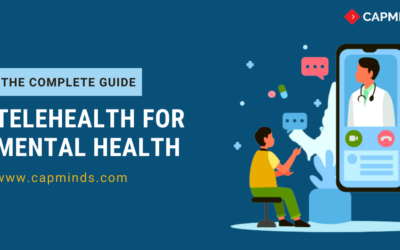The Ultimate Round-Up Of Telehealth Visits In 4 Steps
In response to the COVID-19 outbreak, today many healthcare practices get started with telehealth visits and started enjoying the true benefits of the telehealth platform. Are you new to these telehealth services? In this article, we guide you to telehealth virtual visits just in four steps.
The
Patients & Physicians View About Telehealth Services
It
will be really surprising how telehealth adoption has been raised in the
healthcare industry since 2020. It is also clear that patients are enjoying
telehealth services and were ready and able to embrace its features by sitting
comfortably in their homes. We can’t say that the telehealth platform is just
targeting a specific age group of people.
Across
all age groups, including older patients, people are making the right use of
telehealth visits and they feel very convenient in accessing care on time. As
most of the patients worry about the increased exposure to COVID-19, telehealth
ultimately eliminates the burden associated with in-person appointments.
Now,
when looking from a physician’s point of view, telehealth allows the healthcare
providers to build a more flexible schedule and reduce in-person appointments during
these tough times. So, they can feel more comfortable in providing timely care
to their patients instead of spending time with in-person visits.
The
4 Basic Telehealth Visit Steps
1.
Schedule Online Appointment By Engaging With Your Patients
With telehealth’s adoption is on the rise, your healthcare practice ought to guarantee patients know these services are accessible. Utilizing your patient messaging system like a patient portal, you can send a transmission notice to all patients to declare your telehealth options and guide patients toward the patient appointment scheduling.
From the
portal, patients can likewise get access to e-forms like e-prescription,
medication information, insurance information, and also COVID-19 intake forms
to evaluate for symptoms before their telehealth appointments. Moreover, the
portal permits patients to communicate securely with the physicians via the secure
messaging system.
After
patients request a telehealth visit, your practice’s secure messaging system
should send an appointment through text, email, or voice call. The need for
sharing this message is to confirm their appointment date, time, and instructions
for their online visit.
2.
Remind Your Patients About Their Telehealth Visits
A
day before the appointment, send an appointment reminder text message with
additional instructions. The message can ask patients to visit the portal to
update information and remind them to establish their connection 10 minutes
before the appointment for registration and check-in.
Your
virtual check-in workflow should include verifying patient information,
confirming the preferred pharmacy, ensuring the proper link to the encounter
for billing, and documenting consent for the telehealth visit according to
state regulations.
As
a best practice, determine what information should be checked to verify a
patient’s identity for telehealth visits. For instance, staff could ask for the
patient’s name, date of birth, or phone number. Additionally, if you would have
collected a copay before the appointment in an in-person setting, be sure to
collect it before the telehealth visit.
For providers, preparing for a telehealth visit means following best practices for a welcoming “website” manner. These include dressing professionally, setting up a secure environment for the visit, and ensuring the background is free of distractions.
RELATED: DIGITAL PATIENT INTAKE FOR TELEHEALTH IN 2021
3.
Conduct A Secure Telehealth Visit
The
next step in the telehealth workflow is the visit itself. Providers should
review the patient chart and patient’s medical history just as they would for
an in-person appointment. Additionally, any information or messages in the
patient portal should be imported beforehand for the provider’s review.
Then,
providers should start the visit note, pull the appropriate telehealth
template, and begin the telehealth visit. Providers should work through the
note as usual, while ensuring a good “we” manner through intentional listening
and clear communication.
During
the patient evaluation, the provider will document the patient’s chief
complaint and any other symptoms the patient is experiencing. For the physical
exam, the provider will ask the patient for current height and weight and other
vitals, depending on the patient’s at-home devices. Through audio or
audio/video, providers can listen to the patient’s breathing, assess stress
levels, and capture vital signs to ensure a complete exam.
For the assessment and patient plan, the proper diagnosis codes, orders, medications, and instructions should be added to the note. This information should then be reviewed with the patient to ensure an understanding of the care plan. Unlike in-person visits, telehealth visits don’t allow providers to physically hand patients education materials or printed instructions. Instead, providers should direct patients to the patient portal to view the visit summary and other resources. After ending the telehealth visit, the provider should finish documentation and sign the note.
RELATED: TELEHEALTH EHR INTEGRATION IMPROVES CLINICAL WORKFLOW
4.
Telehealth Billing Should Be Your Last Step
The
day after the appointment, your practice should send the patient a follow-up
text message offering contact information for any questions or concerns and a
link to a patient survey. The patient can log in to the patient portal to view
the visit summary, access patient education resources, pay any balance owed,
and communicate with your practice through secure messaging.
Remember
that the billing cycle doesn’t change with telehealth visits. Use system
functionality to prompt billing staff with reminders. Billing staff should also
check for charge edits.
Final
Thoughts
The
key reason behind the successful adoption of telehealth services by patients
and healthcare providers is how telehealth best enables high-quality healthcare
delivery on time. This telehealth platform will ultimately provide new
opportunities for individualized care and improve overall care.
Interested
In Telehealth Solution For Your Practice?
CapMinds is here to provide the best and secure telehealth services with HIPAA compliant interface which enables healthcare practices to deliver quality care to their patients remotely.

 Author: Pandi Paramasivan
Author: Pandi Paramasivan


